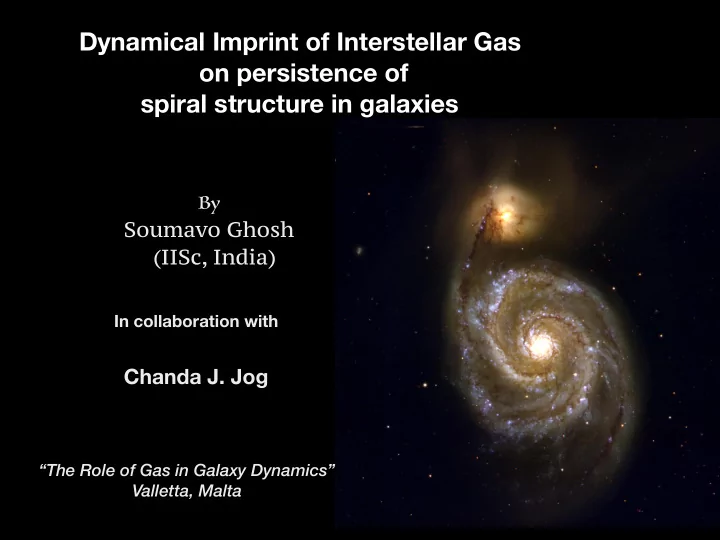

Dynamical Imprint of Interstellar Gas on persistence of spiral structure in galaxies By Soumavo Ghosh (IISc, India) In collaboration with Chanda J. Jog “The Role of Gas in Galaxy Dynamics” Valletta, Malta
Why Interstellar Gas ? Sa ~ 5 % Sb ~ 10 % Interstellar gas is ubiquitous in disk galaxies , especially in late-type ones Sc~ 15 % Scd ~25 % (Young & Scoville, 1991)
Problem to address Does the interstellar gas influence the longevity of the spiral arms? —if yes, how strongly ? Where to look for the signature of interstellar gas on spiral arms? How to extract the effect of interstellar gas on spiral arms?
Why should gas make a di ff erence? Gas makes the system unstable against local, axisymmetric perturbations ( Jog & Solomon 1984; Bertin & Romeo 1988; Rafikov 2001 ) For high gas contribution, stellar spiral features get more amplified — explanation for origin of broad stellar spiral arms (Jog 1992)
Outline of the talk Inclusion of gas decreases the group velocity of the wave packet of • density wave , and hence the longevity of the spiral arms are increased to ~ few times 10^9 yrs Ghosh & Jog, 2015, MNRAS, 434, 56 At the observed pattern speed value, stars-alone do not give a • stable wave solution – instead one must include gas to get a stable density wave Ghosh & Jog, 2016, MNRAS, 439, 929
Role of gas in supporting grand-design spiral structure Collisionless stellar disk Q s = 1 . 7 Perturbations exp [ i ( ω t − kR )] ( ω − Ω ) 2 = κ 2 − 2 π G Σ s | k |F ( s, χ ) Dispersion relation s 2 = 1 − | x |F ( s, χ ) |s|= 1 implies the Lindblad resonances ( ILR & OLR )
Radial Group Transport phenomenon Lin-Shu theory proposed the ‘grand-design’ spiral arms are density waves in the disk (Lin & Shu, 1964, 1966) Any wave packet of density wave • travels radially with its group velocity Information about group velocity can be extracted from the local dispersion relation (Toomre 1969; Binney & Tremaine 1987) ( c g ) = ∂ω / ∂ k Group velocity - can be obtained from the “ slope ” of the dispersion relation c g ( R ) = sgn ( ks )( k/k crit )( ds/dx ) (Toomre 1969)
And then comes the challenge … One-component stellar disk • Targeted region — solar neighbourhood • Calculated group velocity ~ - 10 km/sec • Sufficient to destroy the spiral structure within few galactic revolutions (Toomre 1969) Poses a challenge for the “ Stationary ” picture of the density wave theory !
Two-component Dispersion relation | s | = | ( ω − m Ω ) | / κ Dimensionless frequency | s | = m | ( Ω p − Ω ) | / κ Pattern speed of the Ω p = spiral arm Addition of gas decreases the forbidden region, makes the system • more prone to being unstable Inclusion of more gas in the system makes the • dispersion relation ‘flat’ (Ghosh & Jog, 2015, MNRAS)
Group velocity ( c g ) = ∂ω / ∂ k “ slope ” of the c g ( R ) = sgn ( ks )( k/k crit )( ds/dx ) Dispersion relation Lower slope implies lower group velocity — hence greater longevity of the spiral arms ! Group velocity of such a wave packet of density wave reduces by a factor of few (2 – 3) It helps to persist the spiral structure for a relatively longer time-scale (several billion years) (Ghosh & Jog, 2015)
Dynamical effect of gas on spiral pattern speed in galaxies Perturbations exp [ i ( ω t − kR )] Parameters : Q s , Q g , ✏ | s | obs = m | ( Ω p − Ω ) | / κ | s | obs ≥ | s | cut − o ff Condition for the observed pattern speed to give a ‘ stable density wave’ | s | cut − o ff is smaller for star+gas system than the star-alone case Stars+Gas allows a stable density wave for the observed • pattern speed, whereas stars-alone does not We explore this new idea (Ghosh & Jog, 2016, MNARS)
| s | cut − o ff variation with increasing gas-fraction | s | cut − o ff steadily decrease with the inclusion of more gas in the system — indicative of the system being more prone to be unstable
Particular Case : NGC 6946 ( R = 2 R D ) | s | = | s | obs | s | = | s | obs ( Q g = 1 . 4 − 1 . 7) Q s = 1 . 7 Q s = 1 . 5 Stars + gas allows stable density wave but stars-alone does not (GJ’16)
Particular Case : M 51 ( R = 2 R D ) | s | = | s | obs | s | = | s | obs ( Q g = 1 . 4 − 1 . 7) Q s = 1 . 7 Q s = 1 . 6 Stars + Gas allows a stable density wave but the stars-alone does not (GJ’16) A similar trend is shown to hold true for the Galaxy also (Ghosh & Jog, 2017, IAU Symposium Proceeding)
Take Home Inclusion of gas decreases the group velocity by a factor of few • (factor of 2-3) — helps the spiral arms to survive for relatively longer time (several billion years) (Ghosh & Jog, 2015, MNRAS) Addition of gas is necessary to get a stable density wave, • corresponding to the observed pattern speed (Ghosh & Jog, 2016, MNRAS)
Recommend
More recommend